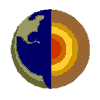|

An oasis is usually thought of as a green, wet place in the desert. In broader terms, it is a place of abundance—a pleasant change from the usual. Thus, an oasis may be in the desert, the sea, or the middle of a city. It is a place that provides for one's needs.
Wherever it is found, an oasis is special. A combination of factors such as geological processes, geographical location, climate, weathering, and the presence of life forms contributes to the overall uniqueness of an area. Baja California, Mexico, with its offshore islands bears witness to the influence of these factors.
|

|
Geographical Location
Baja California, at the southern tip of North America, lies between the north latitudes of 32 degrees 30 minutes and 23 degrees—a range where deserts occur worldwide. The Baja California peninsula, about 760 miles (over 1220 kilometers) in length, is almost surrounded by water with the Gulf of California (Sea of Cortés) to the east and the Pacific Ocean to the west. It is Earth's second-longest peninsula—only the Malay Peninsula is longer.
|

|
Geology
Torn away from mainland Mexico and the North American Plate by the San Andreas Fault, the Baja California peninsula rides on the eastern edge of the Pacific Plate. Over the last four to six million years, the peninsula has slid northwesterly about185 miles (about 300 kilometers). The eastern side of the peninsula has uplifted, and the region of the gulf has sunk and filled with seawater to form the Gulf of California. The close proximity to plate boundaries has contributed to a diversity of landforms, including mountains, canyons, and volcanic areas, both on land and under the sea.
For a video animation and an illustrated step-by-step summary of this process beginning in the Late Jurassic period—140 million years ago—see "Plate Tectonics: How Baja California and the Sea of Cortés were Formed."
|

|
Climate
Influenced by the Pacific Ocean with its cool California Current and by high mountain ranges, the climate of Baja California varies from hot and dry in the desert lowlands to cool and moist at some of the higher elevations. The combination of tectonic forces, climate, and geographical position creates the physical environment and habitats of the region's life forms.
|

|
Living Things
Life forms in and around Baja California are many and varied. Survival, whether on land or in the sea, depends on the ability to adapt to environmental conditions. In Baja California, survival on land often means enduring hot and dry conditions. While in the surrounding Pacific Ocean and Gulf of California, organisms thrive in a range of conditions from warm to cold, shallow to deep, and clear to turbid. However, conditions around the mid-gulf region are ideal for an abundance of life forms, an ocean oasis. Baja California's long shoreline provides a habitat for organisms that use both the land and the sea for their survival.
|

|
Human Presence
Humans have been in Baja California for perhaps 12,000 years. Early people probably followed a nomadic lifestyle, searching for sources of food and water. They fished, gathered food, and eventually grew crops. People continued to arrive, including the Europeans in the 1500s. They introduced their own crops, domestic animals, farming practices, and technologies. While the peninsula has been inhabited for thousands of years, long-term habitation of the islands was and still is limited by the lack of potable water. Over the years the peninsula and its islands have felt the presence of humans through such activities as fishing, tourism, mining, collecting sea bird eggs and guano, and hunting green sea turtles. Deserts and oceans are ecologically sensitive areas that are affected by human activities. Like all areas of the world, the need for conservation and an understanding of global and local environmental problems are critical to the preservation of the Baja California peninsula and its ocean oasis.
|
![[Ocean Oasis - Teacher's Guide]](images/bnr-oo-tg.gif)

![[Ocean Oasis - Teacher's Guide]](images/bnr-oo-tg.gif)
